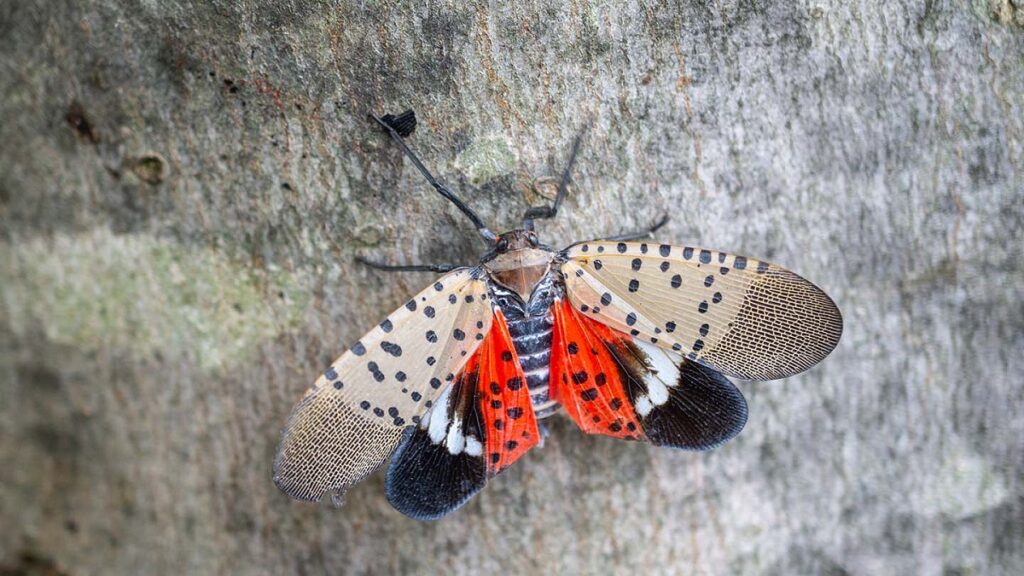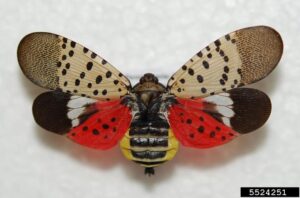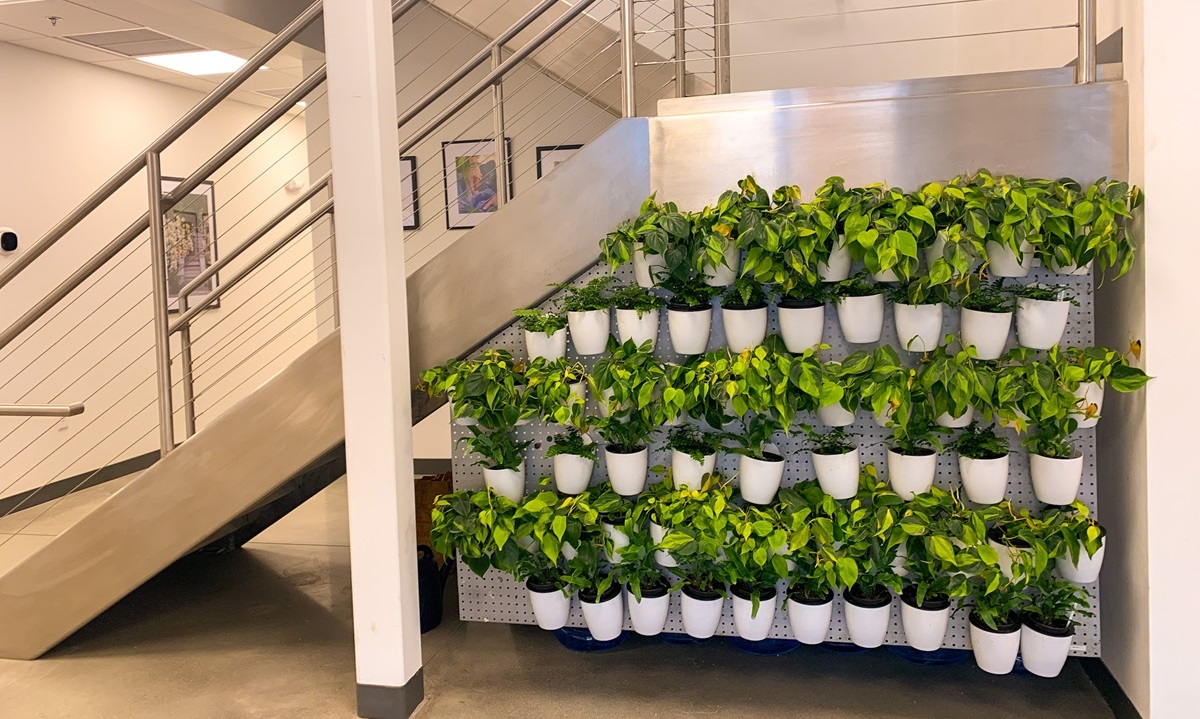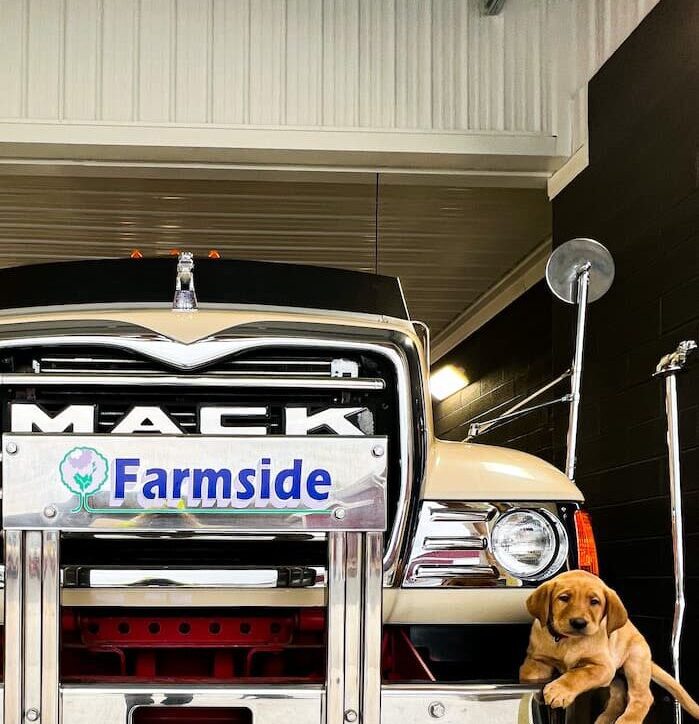Be on the Lookout for the Spotted Lanternfly – The Spotted Lanternfly (SLF), Lycorma delicatula, an invasive pest native to China, India, and Vietnam, was first discovered in the U.S. in Pennsylvania in Berks County in 2014, and has spread to other states including New Jersey, Delaware, Maryland, Virginia, West Virginia, New York, Connecticut and Ohio.
Though harmless to humans and animals, the spotted lanternfly is a voracious eater that causes significant feeding damage such as oozing sap, wilting, leaf curling and dieback in trees, vines, crops and many other types of plants. It uses its piercing-sucking mouthpart to feed on sap from over 70 different plant species. The large number in which these pests amass, contribute to the severity of destruction they cause.
The SLF excretes honeydew (a sugary substance) as it feeds, that can build up and promote the growth of sooty mold (fungi), which can cover and injure plants and forest understories, as well as get on patio furniture, cars, and anything else found below the lanternfly’s feeding area.
Preferred Plantings of the Spotted Lanternfly
Spotted lanternflies have a preference for Ailanthus altissima, the Tree of Heaven, and grapes – both orchard and wild grapes, which has a devastating effect on vineyards. Tree of Heaven is native to China, but was widely planted in much of the eastern U.S. decades ago both for erosion control and as an ornamental street tree in many towns. Female trees produce abundant seeds that can take root in a variety of soils, which has caused the tree to now be regarded as an invasive plant in the US. In addition to Tree of Heaven and grapes, the SLF also likes apple, peach, walnut and maple trees, plus basil plants, vegetables and hops.
Lifecyle of the Spotted Lanternfly
Adults lay eggs in masses in the late fall on trees, posts, lawn furniture, cars, trailers, outdoor grills, firewood – anything left outdoors. Females can lay up to two egg masses, each consisting of 30-50 eggs. Each egg mass is about 1 inch in size. A freshly laid egg mass has a light gray, mud-like covering over the eggs. Older egg masses turn light tan and resemble cracked mud. Hatched egg masses lose their mud-like covering, exposing individual eggs that look like seeds. Research has shown that 80 to 90 percent of egg masses on trees are found 10 feet or more above ground.
Spotted lanternflies go through five stages of growth after hatching from their eggs. In their first four stages (nymph stages) the are incapable of flight. The young nymphs, roughly the size of a pencil eraser, are black with bright white spots. In the next stages of growth, the nymphs look the same, but become larger. In the fourth stage of growth, just prior to adulthood, the spotted lanternfly turns a brilliant red, with distinct patches/stripes of black and bright white spots. Finally, the adult SLF grows to about 1″ long, with grey wings with black spots. When the wings are opened, a bright red underwing with black spots is revealed. While the adults can fly, they generally prefer to hop/jump and glide exposing their hindwings.
Quarantined NJ Counties
There are several counties in New Jersey that have a significant enough infestation of Spotted Lanterfly to be designated as under quarantine. Currently quarantined counties include:
- Burlington
- Camden
- Gloucester
- Hunterdon
- Mercer
- Salem
- Somerset
- Warren
Counties with confirmed, smaller SLF populations and /or regulatory incidents include:
- Atlantic
- Bergen
- Cumberland
- Essex
- Hudson
- Middlesex
- Monmouth
- Morris
- Ocean
- Passaic
- Sussex
- Union
"At this point in the season, SLF are currently black with white spots on their bodies. In their next stage of life they will be red, and they will be reaching their full adult stage in August. Once they reach their full adult stage is when most people notice them because they become more mobile and can effect the appearance of your trees with their black sooty looking mold. This is an invasive pest and should be treated and killed as soon as you discover them on your property!"
- Richard Kuperus, Plant Health Care Manager
SLFs are excellent “hitchhikers” so quarantined counties have guidelines to help keep the pest from spreading further within and outside of the state. This is particularly important for transportation businesses and delivery drivers. Quarantine protocols include:
- Carefully inspecting vehicles, trailers, or any outdoor items before moving around or out of a quarantine zone. Check doors, sides, bumpers, wheel wells, grills, and roofs. If found, destroy any eggs or insects you find.
- Avoiding parking under tree lines and keep windows rolled up when parking your vehicle. If possible, try to park 15 feet away from trees if in a quarantine zone.
- Inspect items being moved. Check shipping containers, propane tanks, pallets and other items being stored outdoors before they are moved off-site. Inspect incoming goods for egg masses and insects.
- Report sightings outside quarantined zones by contacting the state agricultural department. If possible, take a picture or capture the insect and kill it/preserve it in alcohol.
- Businesses operating in quarantine zones must have permits to move equipment and goods. Visit https://extension.psu.edu/slf-permit-training-nj for more information about permits.
- Pest Management
- It’s important to destroy any egg masses you may find as well as crush any nymphs and adult insects. Also report any sightings to help keep track of infestations.
- Crush nymphs and adult insects. Scrape egg masses into a doubled plastic bag and place in trash. Note that Spotted Lanternflys are notoriously good jumpers.
- Make a homemade spray to kill SLFs by mixing equal amounts of Dawn dish soap and water in a spray bottle. Spraying this mixture directly on the bugs kills them. The mixture is sticky and drowns the lanternflies. You can even use this mixture to destroy lanternfly eggs.
- Remove host trees such as Trees of Heaven, if possible, to avoid attracting and supporting SLFs.
- Contact the state agricultural department to report sightings outside of quarantined zones. If possible, take a picture or capture the insect in alcohol. Reports are recorded in a database for use by the NJDA and USDA to manage this pest. The database is used to help determine infested areas and possible treatment for high-risk properties. Treatment is based on location, risk, and available county funds.
- Familiarize yourself with the life stages of the insect as well as the appropriate time in the season to look for them.
- Survey your own property and community for possible SLF life stages. Any efforts you make in destroying the Spotted Lanternfly or its egg masses will help reduce populations and infestations.
To report a sighting, use the New Jersey state’s spotted lanternfly reporting tool or call 833-4BADBUG (833-422-3284). For other questions, email the state agricultural department at SLF-plantindustry@ag.nj.gov.
Main Image Photo Credit: Lafayette.edu – New Research Helps Battle Against Spotted Lanternfly

Image Credit: NJ.gov – Spotted Lanternfly











